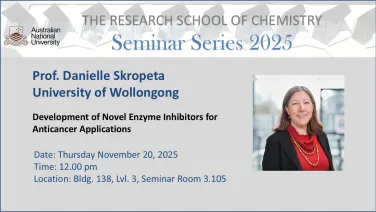RSC School Seminar - Dr. Mark Hackett (Curtin University)
Title: Multi-Modal Spectroscopic Imaging to Study Brain Disease: Metal Ions, Memory Loss and More!
Event series
Content navigation
Description

Title: Multi-Modal Spectroscopic Imaging to Study Brain Disease: Metal Ions, Memory Loss and More!
Speaker: Dr. Mark Hackett
Abstract: Neurodegeneration during brain disease or following brain injury is a major health and economic concern with limited treatment options. The lack of effective therapies can be attributed in part to an incomplete understanding of how injury or disease perturbs brain chemistry. In particular, metal ions are known to be essential for healthy brain function, and altered levels of metal ions are associated with disease pathology; yet much remains unknown about the specific chemical mechanisms through which metal ions participate in brain disease or degeneration. To increase understanding of the role of metal ions in health and disease, new imaging techniques are required to enable visualisation of metal homeostasis at the single cell level, in brain tissue.
Advances in imaging techniques such as synchrotron X-ray fluorescence microscopy (XFM) and micro X-ray absorption spectroscopy (µXAS) are making an important contribution to our understanding of brain function and malfunction. This is due to their capability to directly image diffusible ions (K+, Ca2+, Cl-) and transition metal ions (Fe, Cu, Zn) at cellular resolution. Integration of XFM and µXAS alongside vibrational spectroscopy and traditional histochemical methods in a multi-modal approach enables association between cell physiology, altered metal ion homeostasis, protein aggregation, oxidative stress, and disturbed brain metabolism. My presentation will highlight recent research developments and advances using the above spectroscopic techniques for direct in situ imaging within ex vivo tissue sections of animal models of neurodegeneration (specifically stroke and dementia).
Biography: I completed my undergraduate degree in Analytical Chemistry at Curtin University in 2006, and moved to The University of Sydney to undertake my PhD from 2007 – 2010. My PhD was completed in the research group of Professor Peter Lay where I developed spectroscopic imaging protocols to study neurochemical mechanisms of cerebral malaria. My PhD provided the unique opportunity to be involved in commissioning experiments at both XFM and IRM beamlines at the Australian Synchrotron, as well as at several international synchrotron facilities. Following my PhD I moved to the University of Saskatchewan, Canada, joining the research groups lead by Canadian Research Chairs and international experts in synchrotron science, Professors Ingrid Pickering and Graham George. I was fortunate enough to win two highly competitive research fellowships in Canada, including a 3-year Canadian Institute of Health Research Fellowship. The two fellowships provided the rare opportunity to access multiple synchrotron facilities across North America where I was able to drive development of beamline-end stations optimised for biological experiments. I returned to Australia in 2016 to commence a research and teaching lectureship at Curtin University. I currently hold an ARC Future Fellowship and my main research focus is to develop synchrotron imaging methods to understand the role of metal ions in memory function during natural ageing.


